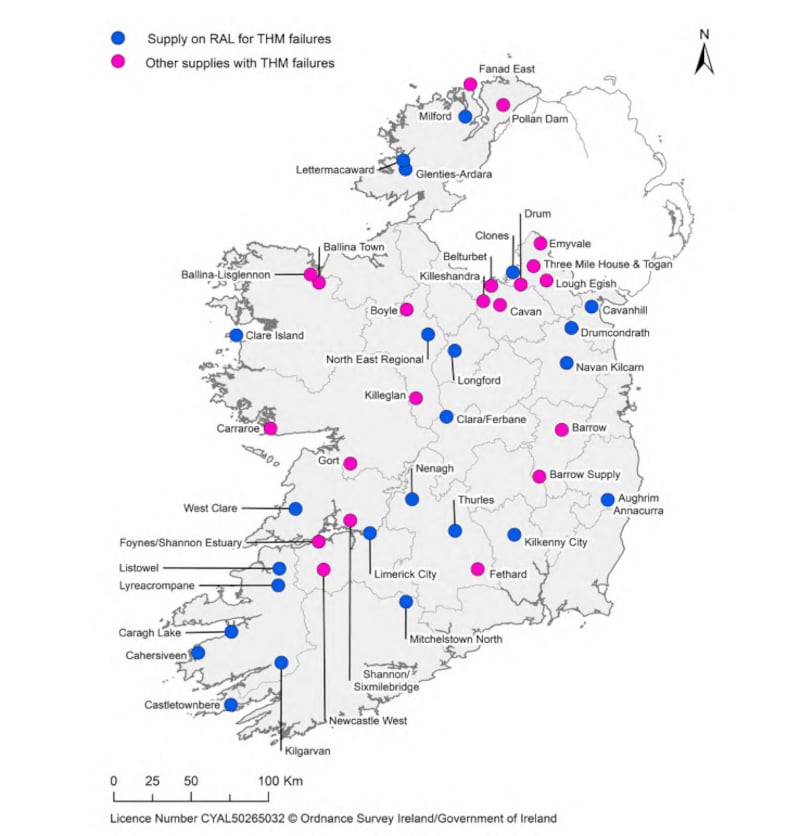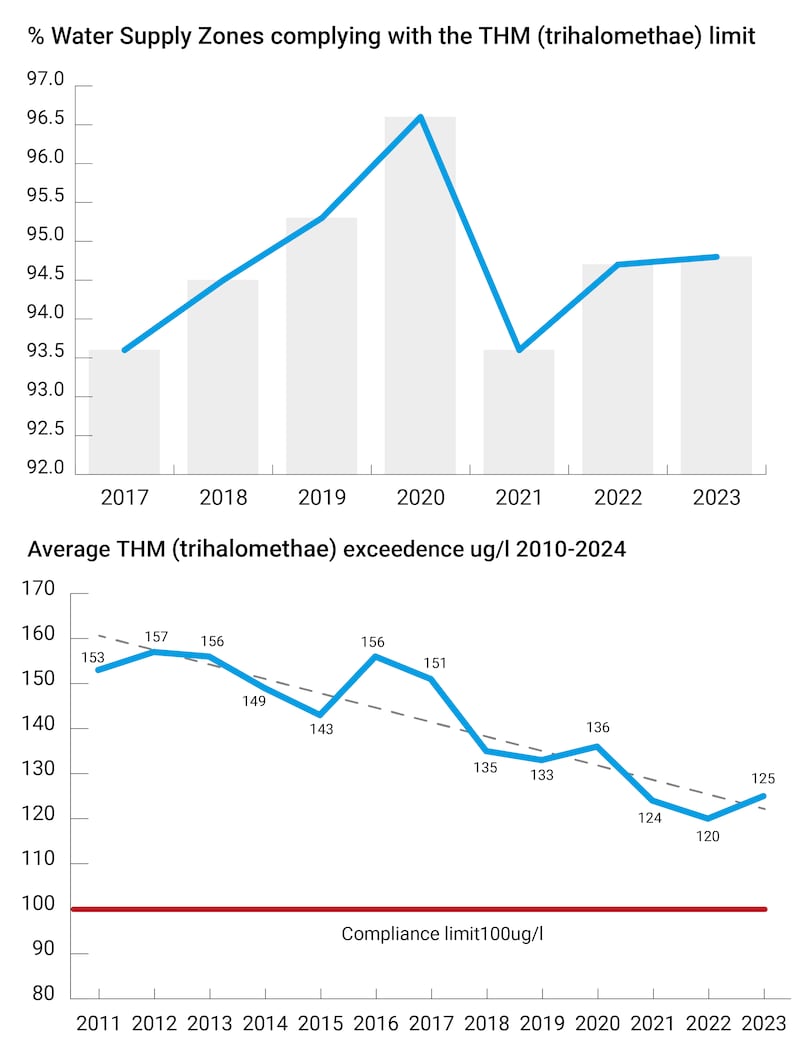More than half a million people in the State are now served by “at risk” public water supplies, with the number increasing again in 2023 to 561,000, up from 481,000 in 2022, according to the Environmental Protection Agency’s (EPA) annual report on drinking water.
Deterioration in supplies was mainly due to detections of persistent levels of toxic trihalomethanes (THMs) and the parasite cryptosporidium, which can make people ill — especially those with weak immune systems.
One in 20 supplies failed to meet the THM standard in 2023, affecting 300,000 people, up from 235,000 in 2022 — an issue repeatedly highlighted by the EU as the chemical, which can arise as a byproduct of disinfection, has been linked in some studies to cancer.
“Greater effort is needed by Uisce Éireann to implement improvements at supplies to minimise exposure to THMs, including at big supplies such as Limerick city, and Kilkenny city,” it warns.
READ MORE

THMs can form when organic matter present in drinking water reacts with chlorine. Some studies have suggested a link between cancer and long-term exposure (over years) to THMs and also that THMs can affect reproduction. There is some evidence that THMs cause cancer in animals, and as a result, they are classified as “possibly carcinogenic” to humans.
The European Commission started infringement proceedings against Ireland in 2015 for failure to comply with the drinking water directive THM standard. The EU Court of Justice ruled in January that Ireland had failed to fully implement the directive concerning THMs in 30 supplies.
While “the quality of drinking water from public supplies remains very high, with over 99.7 per cent of samples compliant with bacterial and chemical limits”, the resilience of supplies must improve and will require sustained investment into the future, according to the EPA.
The number of long-term boil water notices was 46 in 2023, almost double the number in 2022, it adds, while “progress to remove lead from our supply networks to protect public health is far too slow”.

Too many supplies still lack robust treatment measures to guarantee their long-term resilience and safety, the report warns.
The EPA’s remedial action list (RAL) identifies “at-risk” supplies that require improvements by Uisce Éireann to safeguard public health. While 10 supplies were removed from the RAL following improvement works, the EPA identified a further nine “at-risk” supplies.
Good progress has been made in other areas such as disinfection, progressing of the drinking water safety plan approach and making the lead remediation grant easier for the public to access, it finds.
“Our public water quality remains very high, which means that the public can remain confident that drinking water supplied to their homes is safe to drink,” said EPA director Dr Tom Ryan. “However, the resilience of drinking water supplies isn’t robust enough as evidenced by more ‘at-risk’ supplies being identified by the EPA, and an almost doubling of long-term boil water notices in 2023.”
Implementing findings of drinking water safety plans was crucial to improve the resilience of supplies backed by sustained investment in water services, he said.
While more than 61,000 lead connections have been replaced since 2014, EPA progamme manager Noel Byrne said: “Lead in our drinking water is a cumulative risk to human health and must be removed from our drinking supply network. Despite Ireland having a national lead strategy in place since 2015 progress to date has been far too slow.”
“Uisce Éireann must accelerate the rollout of their lead mitigation plan to deal with the public supply network; the Department of Housing, Local Government and Heritage and Department of Health must outline their plans for lead replacement in public buildings and householders with lead pipes in their homes should avail of the enhanced lead remediation grant scheme to protect their health,” he said.
In 2023, boil water notices impacted 254,000 people. Half of boil water notices were in place for more than 30 days, nearly double the number from 2022. This recent trend of significantly more long-term boil water notices needs to be reversed by Uisce Éireann and requires proactive measures to address the underlying causes and improve the resilience of these supplies, the report says.
“Ireland’s public drinking water supplies remain among the best in the world, with an impressive 99.7 per cent compliance with microbiological and chemical standards,” Uisce Éireann said.
“The EPA report recognises the ongoing improvements made by Uisce Éireann in testing, monitoring and assessing water supplies and the key role this has played in identifying risks to drinking water quality, and ensuring a safer water supply for all,” Its head of water operations Margaret Attridge added.
Uisce Éireann said it is taking action to remove the risk of elevated levels of THMs forming in all public water supplies. “At the end of 2016, there were 71 supplies on the RAL for THMs, impacting 464,791 customers. As of the end of 2023, there were 25 supplies serving 300,000 on the RAL for elevated levels of THMs above the standard in the Drinking Water Regulations.
“When our monitoring programmes detect THM levels above the allowable limit (100µg/L), Uisce Éireann notifies the EPA and consults with the Health Service Executive to ensure any potential risk to public health is fully risk assessed. To date, a ‘do not drink’ notice has not been imposed on any public water supply due to THM exceedances. We are also planning further communications to customers on THMs explaining what they are and next steps for their supplies in the Autumn,” it said.
Most of the boil water notices imposed in 2023 were in place for less than 30 days, Ms Attridge said, while it continues to make progress in addressing known risks to water supplies which are on the RAL.
“In 2023, 10 more supplies were removed from the list following the completion of remedial actions. For those supplies that remain on the list or for those added, Uisce Éireann is progressing plans to address any underlying issues and ensure resilient water supplies for the communities they serve.”
In 2023 it invested over €530 million in treatment plants and networks, with a number of new water treatment plants built or significantly upgraded and an additional 30 sites enhanced under the national disinfection programme.
A €59 million treated water reservoir at Saggart, Co Dublin was completed and significant upgrades of treatment plants at Leixlip, Ballyboden and Ballymore Eustace, benefitting homes and businesses in the Greater Dublin Area.
New or upgraded water treatment infrastructure was provided in Callan and Piltown/Fiddown (Kilkenny), Batterstown (Meath), Aughrim/Annacurra and, Gorey Rural Regional (Wexford) and Mullingar (Westmeath).
“We recognise that challenges remain, and it will take sustained high levels of investment across a number of investment cycles to address all legacy issues,” Ms Attridge said, “but we are confident that our ambitious capital investment programme will enable us to transform Ireland’s water services and ensure a safe, sustainable, secure and reliable drinking water supply for everyone now and into the future, supporting communities to thrive.”
- Sign up for push alerts and have the best news, analysis and comment delivered directly to your phone
- Join The Irish Times on WhatsApp and stay up to date
- Listen to our Inside Politics podcast for the best political chat and analysis










